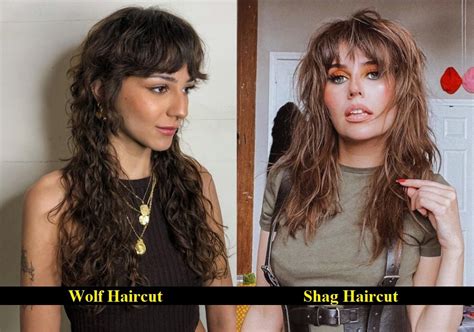TABLE OF CONTENTS:
- What is a Wolf Cut vs. a Shag?
- Compare Wolf Cut and Shag
- Wolf Cut and Shag Hairstyles
- How to Style a Wolf Cut vs. a Shag
- Wolf Cut vs. Shag: Which Cut Suits You?
- FAQs
Wolf Cut vs. a Shag: Styling with an Edge
When it comes to edgy and effortlessly cool hairstyles, the wolf cut and the shag take the spotlight. These kindred spirits in the realm of hair fashion share a rebellious spirit, but they also flaunt their own distinct identities. If you’re torn between these two game-changing cuts, this comprehensive guide will help you unravel their nuances, guiding you towards the perfect choice that amplifies your unique style and personality.

While both the wolf cut and the shag embrace a layered, textured silhouette, they showcase their individuality in several key elements:
| Characteristic | Wolf Cut | Shag |
|---|---|---|
| Length | Typically shorter, ranging from ear-length to shoulder-length | Versatile, ranging from short to long |
| Layers | Heavily layered throughout, creating a dynamic and choppy texture | Layered, but layers tend to be less pronounced and more blended |
| Texture | Rougher, more piece-y texture with a “lived-in” feel | Softer, more refined texture with a slightly more polished finish |
| Bangs | Often incorporates curtain bangs or micro bangs | Can incorporate bangs, but they are not a defining characteristic |
Similarities between Wolf Cut and Shag:
- Both have a layered structure, providing volume and movement.
- Both exude an edgy, effortless vibe.
- Both are versatile, allowing for customization to suit different face shapes and hair types.
Embark on a visual journey as we showcase a captivating array of wolf cut and shag hairstyles that embrace their unique aesthetics:
- Wolf Cut:
- Messy, choppy layers that create a rebellious, edgy look.
- Face-framing layers that accentuate cheekbones and draw attention to the eyes.
- Short to medium length, often ending around the chin or shoulders.
- Complementing curtain bangs or micro bangs for a touch of softness.
- Shag:
- Long, flowing layers that exude a bohemian, effortless vibe.
- Natural, beachy waves enhance the volume and texture.
- Longer than wolf cuts, falling anywhere from the shoulders to the waist.
- Subtle, blended layers that create a more polished, refined finish.
- Can incorporate bangs of various styles, such as side-swept or curtain bangs.
Mastering the art of styling a wolf cut or a shag requires a tailored approach that enhances their unique textures:
Wolf Cut Styling:
- Step 1: Start with freshly washed hair.
- Step 2: Apply a volumizing mousse or root lifter to damp hair, focusing on the roots.
- Step 3: Blow dry hair upside down for maximum volume.
- Step 4: Use a round brush to create loose curls or waves, alternating directions for a more natural finish.
- Step 5: Finish with a medium-hold hairspray to lock in your style.
Shag Styling:
- Step 1: Begin with clean, conditioned hair.
- Step 2: Apply a leave-in conditioner or curl cream to damp hair, distributing it evenly.
- Step 3: Air dry hair naturally or use a diffuser to enhance curls.
- Step 4: Use a wide-toothed comb to detangle hair, creating soft, effortless waves.
- Step 5: Finish with a light mist of hairspray to maintain your beachy, bohemian style.
Finding the perfect cut between the wolf cut and the shag hinges on your unique preferences and facial features:
-
Face Shape: Wolf cuts are ideal for oval, round, and square faces, as they can balance out angles and create a more elongated appearance. Shags, on the other hand, suit most face shapes due to their versatility.
-
Hair Type: Wolf cuts work well on medium to thick hair textures, as they add volume and movement. Shags, however, can flatter various hair types, from fine to thick.
-
Lifestyle: Wolf cuts require more styling effort to maintain their edgy texture. Shags, on the other hand, are relatively low maintenance and embrace natural waves and movement.
-
Personal Style: Wolf cuts exude a rebellious, fashion-forward vibe, while shags embody a more bohemian, carefree aesthetic.
1. Which cut is more versatile?
Shags offer more versatility, as they can be styled in various ways and suit most hair types.
2. Which cut requires more styling effort?
Wolf cuts require more styling effort to achieve their signature choppy texture, while shags are relatively low maintenance.
3. Which cut is better for fine hair?
Shags are generally more suitable for fine hair, as they create volume and movement without overpowering the hair.
4. Which cut is more popular?
Wolf cuts have gained immense popularity in recent years, especially among fashion-forward individuals.
5. Which cut is more timeless?
Shags have a more timeless appeal, as they have been a recurring trend for decades.
6. Which cut is better for thick hair?
Both wolf cuts and shags can work well on thick hair, but wolf cuts may require more layering to reduce bulk.
Conclusion:
The wolf cut and the shag represent two distinct yet captivating styles that cater to different preferences and hair personalities. Whether you crave the edgy, rebellious spirit of the wolf cut or the effortless, bohemian charm of the shag, understanding their nuances will empower you to choose the cut that harmonizes seamlessly with your unique style and confidence. Embrace your inner stylist and experiment with these versatile haircuts to find the perfect match for your self-expression.
